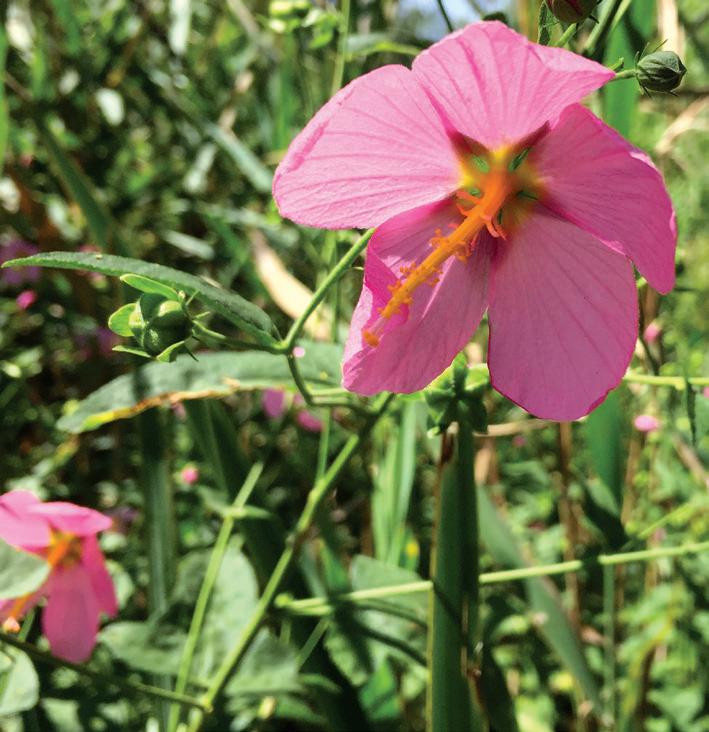
2 minute read
Wildflowers of the Year bloom throughout Virginia
they thrive,” Hayden explained. “They like lawns, gardens, roadsides—nonnatural habitats present in abundance these days, because people are in abundance. We’re largely responsible for their presence because they like what we do to the environment.”
Don’t remove wild plants
Advertisement
Gardeners should be certain that all native plants purchased for home gardens have been nursery-propagated, not wild-collected.
“Digging them up is not a sustainable way to conserve populations of native plants,” Hayden warned. “Reputable nurseries will get seeds or cuttings from wild plants without removing whole plants intact in their habitat. Picking it up by the roots is subtracting the entity from the environment.”
One stem cutting taken early in the growing season will likely have minimal impact, though not all species can be propagated by cutting.
2023 Hollow Joe-Pye Weed (Eutrochium fistulosum)
Flowers: Mid-summer into fall
Locations: Most Virginia counties
Where to spot them: Wet sand prairies, soggy thickets and shorelines
Notable attributes: “These are members of the Aster family,” Hamilton said. “Joe-Pye weeds have no rays (petals), only disk flowers, and they are tiny, allowing small insects easy access to nectar.”
In the garden: Full sun and somewhat moist soils. Its tall stems look best placed near the rear of a garden where its large flower clusters provide color and attract diverse pollinators.
2018 Flowering Dogwood (Cornus florida)
Flowers: April to May
Locations: Statewide
Where to spot them: Forest understory
Notable attributes: It’s both the Virginia state tree and flower. “People love dogwoods,” Hayden said. “They’re relatively small trees that won’t dwarf your house in a landscape setting.”

In the garden: Providing attractive spring flowers and brilliant fall color, the trees thrive in rich mesic soils but also tolerate drier, less-fertile sites.

2016 Downy Rattlesnake Plantain (Goodyera pubescens)

Flowers: July and August
Locations: Throughout Virginia, especially mountainous areas
Where to spot them: Dry forest floor, often under leaf litter
Notable attributes: It’s an orchid with evergreen leaves. “A lot of people don’t realize we have native orchids in Virginia,” Hayden said. “The flowers are quite small, but there are bunches of them in a spike. The green leaves with white netting pattern are strikingly beautiful year-round. You can find them in the forest in the middle of winter.”
In the garden: Requires dappled sunlight, acidic soils with organic matter and a layer of mulch to ensure consistent soil moisture.
Wildflowers
2008 Virginia Spiderwort (Tradescantia virginiana)

Flowers: April to July
Location: Widespread through half of Virginia counties
Where to spot them: Acidic soils of dry upland forests, rocky open woods and wood edges.
Notable attributes: “They’re strikingly pretty and easy to grow,” Hayden said. “The ones I have self-sow and pop up here and there. I’ve had them reflower late summer into the fall.”
In the garden: Grows best in fertile loam, and prefers somewhat acidic soils, but is adaptable. Cutting stems back after flowering stimulates re-blooming.

2004 Seashore Mallow (Kosteletzkya virginica)
Flowers: July to October
Location: Atlantic and Chesapeake Bay shores of Virginia
Where to spot them: Grasses, rushes and sedges along salt or brackish marsh
Notable attributes: Rosy-pink, 2”-3” blooms stand out among summer’s greenery, identifiable even from a speeding car.
In the garden: Plant in rich, moist to wet soil in full sun.
2000 Flame Azalea (Rhododendron calendulaceum)

Flowers: June and early July
Location: Mountainous counties of Central and Southwest Virginia
Where to spot them: Open woods, waysides, grassy balds and pastures southward along the Blue Ridge Parkway
Notable attributes: “If you’re out in the woods while they’re in flower, and you spot one out of the corner of your eye, you might think there’s a fire,” Hayden said.
In the garden: Part shade or full sun; many propagated forms thrive in the cooler parts of Virginia.
1989 Virginia Bluebells (Mertensia virginica)

Flowers: Mid-to-late April
Location: Potomac River watershed and along the Shenandoah and Cacapon rivers. Bull Run Regional Park in Centreville claims the largest stand of bluebells on the East Coast. Where to spot them: Stream banks, low, moist woods and floodplains
Notable attributes: “The buds are pink, but by the time the flowers fully open, they have that nice sky-blue color,” Hayden said. “It’s a blue that’s a little bit unusual in flower color.”
In the garden: Grown with bulbs in partially shaded perennial borders.










